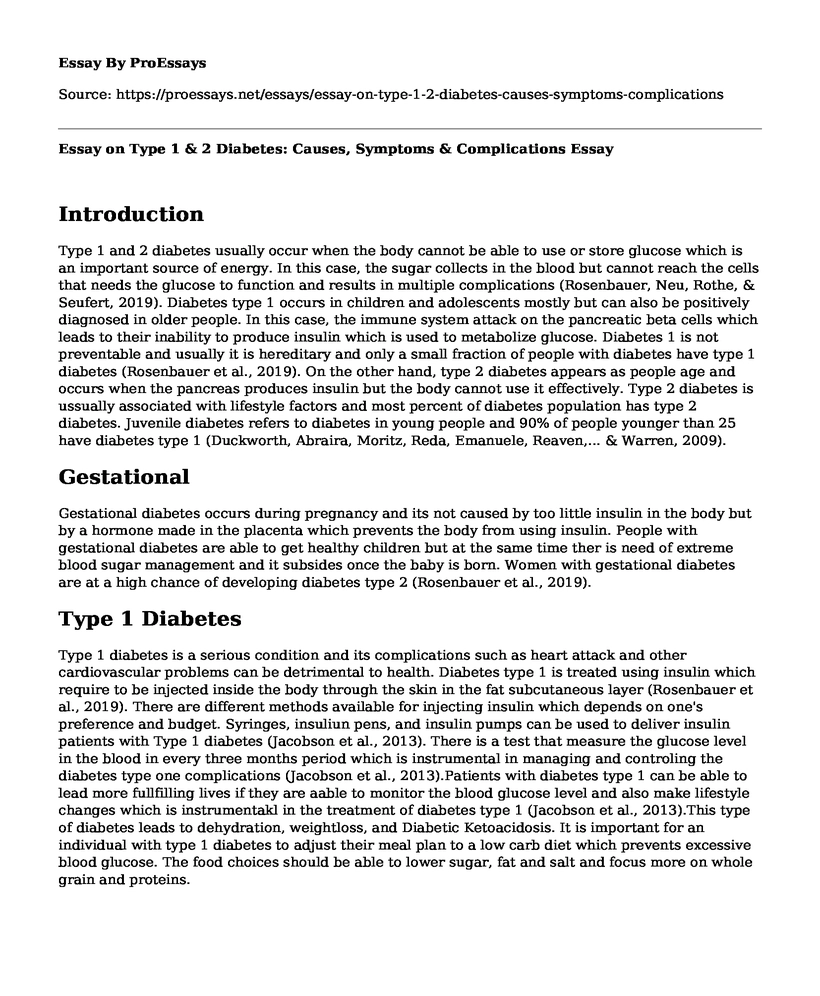Introduction
Type 1 and 2 diabetes usually occur when the body cannot be able to use or store glucose which is an important source of energy. In this case, the sugar collects in the blood but cannot reach the cells that needs the glucose to function and results in multiple complications (Rosenbauer, Neu, Rothe, & Seufert, 2019). Diabetes type 1 occurs in children and adolescents mostly but can also be positively diagnosed in older people. In this case, the immune system attack on the pancreatic beta cells which leads to their inability to produce insulin which is used to metabolize glucose. Diabetes 1 is not preventable and usually it is hereditary and only a small fraction of people with diabetes have type 1 diabetes (Rosenbauer et al., 2019). On the other hand, type 2 diabetes appears as people age and occurs when the pancreas produces insulin but the body cannot use it effectively. Type 2 diabetes is ussually associated with lifestyle factors and most percent of diabetes population has type 2 diabetes. Juvenile diabetes refers to diabetes in young people and 90% of people younger than 25 have diabetes type 1 (Duckworth, Abraira, Moritz, Reda, Emanuele, Reaven,... & Warren, 2009).
Gestational
Gestational diabetes occurs during pregnancy and its not caused by too little insulin in the body but by a hormone made in the placenta which prevents the body from using insulin. People with gestational diabetes are able to get healthy children but at the same time ther is need of extreme blood sugar management and it subsides once the baby is born. Women with gestational diabetes are at a high chance of developing diabetes type 2 (Rosenbauer et al., 2019).
Type 1 Diabetes
Type 1 diabetes is a serious condition and its complications such as heart attack and other cardiovascular problems can be detrimental to health. Diabetes type 1 is treated using insulin which require to be injected inside the body through the skin in the fat subcutaneous layer (Rosenbauer et al., 2019). There are different methods available for injecting insulin which depends on one's preference and budget. Syringes, insuliun pens, and insulin pumps can be used to deliver insulin patients with Type 1 diabetes (Jacobson et al., 2013). There is a test that measure the glucose level in the blood in every three months period which is instrumental in managing and controling the diabetes type one complications (Jacobson et al., 2013).Patients with diabetes type 1 can be able to lead more fullfilling lives if they are aable to monitor the blood glucose level and also make lifestyle changes which is instrumentakl in the treatment of diabetes type 1 (Jacobson et al., 2013).This type of diabetes leads to dehydration, weightloss, and Diabetic Ketoacidosis. It is important for an individual with type 1 diabetes to adjust their meal plan to a low carb diet which prevents excessive blood glucose. The food choices should be able to lower sugar, fat and salt and focus more on whole grain and proteins.
The Short Term and the Longterm impacts of Diabeyes 1
Uncheckhed blood glucose can result in atherorosis, harm blood vessels in the heat and the kidney and to the extreme can lead to heart attacks. Diabetes type 1 has both short term and negative implications (Jacobson et al., 2013).Diabetes type 1 significantly interferes with one's quality of life by increasing their vulnerabilities to health conditions that can in the longterm become chronic. The long term metabolic changes and other mild complications can be adressed through constant evaluation and history documentation. The drugs used to manage diabetes leads to kidney complications, bloating, diarrhoea and weight gain (Jacobson et al., 2013).
References
Duckworth, W., Abraira, C., Moritz, T., Reda, D., Emanuele, N., Reaven, P. D., ... & Warren, S. R. (2009). Glucose control and vascular complications in veterans with type 2 diabetes. New England journal of medicine, 360(2), 129-139. Retrieved from https://www.nejm.org/doi/full/10.1056/NEJMoa0808431
Jacobson, A. M., Braffett, B. H., Cleary, P. A., Gubitosi-Klug, R. A., Larkin, M. E., & DCCT/EDIC research group. (2013). The long-term effects of type 1 diabetes treatment and complications on health-related quality of life: a 23-year follow-up of the Diabetes Control and Complications/Epidemiology of Diabetes Interventions and Complications cohort. Diabetes care, 36(10), 3131-3138. Retrieved from https://care.diabetesjournals.org/content/36/10/3131
Rosenbauer, J., Neu, A., Rothe, U., & Seufert, J. (2019). Types of diabetes are not limited to age groups: type 1 diabetes in adults and type 2 diabetes in children and adolescents. Journal of Health Monitoring, 4(2). Retrieved from https://www.rki.de/EN/Content/Health_Monitoring/Health_Reporting/GBEDownloadsJ/Focus_en/JoHM_02_2019_Types_Of_Diabetes_Not_Limited_To_Age_Groups.pdf?__blob=publicationFile
Cite this page
Essay on Type 1 & 2 Diabetes: Causes, Symptoms & Complications. (2023, Jan 26). Retrieved from https://proessays.net/essays/essay-on-type-1-2-diabetes-causes-symptoms-complications
If you are the original author of this essay and no longer wish to have it published on the ProEssays website, please click below to request its removal:
- What Can Nursing Homes Do to Foster Healthy Sexual Expressions Among Residents?
- Whether Blacks Have Higher Rates of Hypertension as Compared to White Races?
- Essay Sample on Cannabis in Healthcare
- Research Paper on Obesity and Sepsis in Hospitalized Patients
- Paper on Nurse Manager in Critical Care: Passionate and Motivated Candidate
- Essay Sample on Partnering with Alabama Public Health Districts: Health & Community Benefits
- Research Paper Sample on Arsenic Exposure: Health Risks and Long-Term Effects







